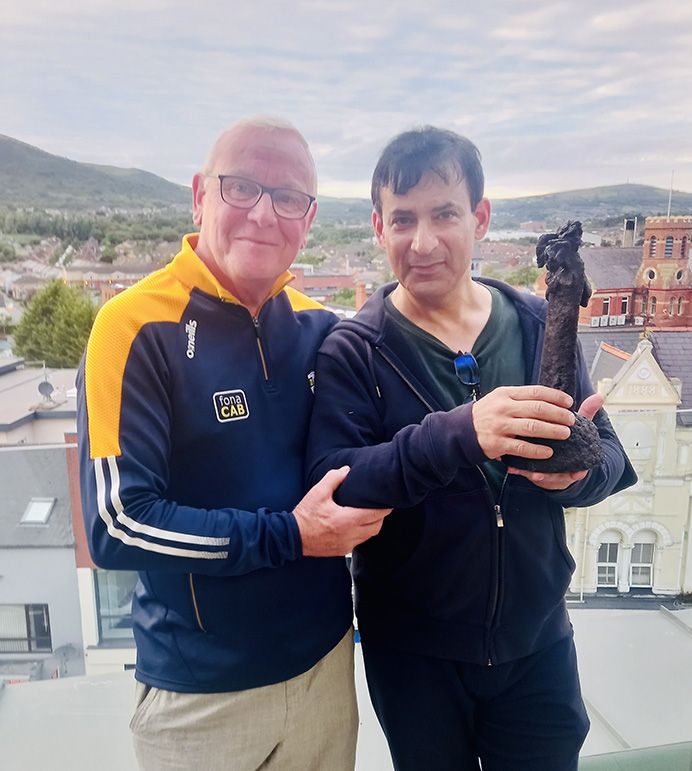WOULDN’T it be something if you could condense the essence of Ireland into a single object so small you could keep it with you to admire and take inspiration from?
It’s hard to imagine if that would even be possible, but that was the challenge facing acclaimed West Belfast-based artist Farhad O’Neill. And it wasn’t as if he could choose his own materials. Because this was as unique and unusual a commission as he had ever been asked to undertake.
The story began 40 years ago just after Jake Mac Siacais was released from prison. He was spending time down south and before returning he decided to take something as a reminder of that time and what had happened there. Dúlra might have bought a rock or even a snow globe, but Jake decided to pick up... a piece of turf!
He brought it back to his Belfast home and there it sat, soon to be joined by another, and another. It took four decades, but he managed to get a piece of peat from every county in Ireland, and all at a time when something significant was happening in that county.
“I didn’t quite know what I was going to do with them,” Jake said this week. But soon he thought: what if someone could make a single piece of art from all 32 pieces?
And the perfect guy happened to have just recently opened a workshop in West Belfast’s Gaeltacht Quarter: Farhad O’Neill. Farhad returned to the city he loves after spending 17 years in Canada caring for his parents.
Before that he had worked for years out of Conway Mill and his public art is scattered throughout West Belfast, including the bronze statue of Cú Chulainn at the Mill and stone sculptures at Aitnamona and Monagh Road. And so Jake asked Farhad if he would accept the challenge.
This week Farhad unveiled the result of his toil: a beautiful black ‘statue’ that encases not just Irish mythology, but in some ways, through the turf, Ireland itself.
“There are loads of stories in that piece, stories from every county,” Jake said as he unveiled the sculpture in his Gaeltacht Quarter office.
“They were just small pieces of turf, but three of them were bigger than the others which I got from the places associated with the triple goddesses of Ireland – Banba, Fódhla and Ériu in Newgrange, Cruachán in Connacht and Emain Macha in Armagh.
“The three sisters are one person, but they have different aspects. When she’s Ériu, she’s the Earth goddess, when she’s Fódhla, she’s the mother of the country and when she’s Banba, she’s the goddess of war. And Banba out of the three of them is particularly apt – she is able to shiftshape into different guises and her most famous representation is on Cú Chulainn’s shoulder as a raven on that statue at the GPO.”
With those challenging criteria, Farhad set to work. He put the three ‘goddess’ pieces of turf to one side and ground the others into powder so they could be moulded into an ogham stone, a miniature version of those mysterious standing stones with messages in an ancient script which still dot our countryside.
“I worked the three bigger pieces into three faces,” Farhad said. “The face of Ériu was more of a mother figure, Fódhla was the only sort of feminine piece, and Banba was more like Cú Chulainn.”
He added: “It’s Gaelic, it’s also modernist and it’s cubist,” he said, referring to the early 20th century movement where objects are broken up and reassembled in abstract form.
The ogham script on the side of the sculpture reads ‘Éigse’, which has various meanings, said Jake. “It means a learned assembly, which is the three goddesses. It also means wisdom and poetry.”
Jake points out that it’s thanks to Belfast’s famous poem – Lon Dubh Loch Lao, the Blackbird of Belfast Lough – that we can read ogham script. That poem helped unlock the linear language whose meaning had been lost to us.
Jake is delighted with the final sculpture.
“There’s something special about turf. I still take my kids to dig turf up in Fermanagh, which is my great grandmother’s homeplace, although now of course our bogs are rightfully being protected.
“But I always say to them, ‘When you light the turf, what you are doing is releasing the solar energy that warmed the Fianna and the Red Branch Knights. You’re actually feeling the same heat that heated the prehistoric Irish.’ The turf gives us a connection to them – as does this sculpture.”

• A reader spotted this absolutely smashing dragonfly in Portadown train station this week (above). It’s a golden beauty that’s more striking than the most intricate broach. It’s a brown hawker, seabhcaí ómrach (amber) in Irish. It’s a female, as the male has blue dots on its body. This lady will continue to brighten up County Armagh after it was released from the stifling station by caring staff.
If you’ve seen or photographed anything interesting, or have any nature questions, you can text Dúlra on 07801 414804.









